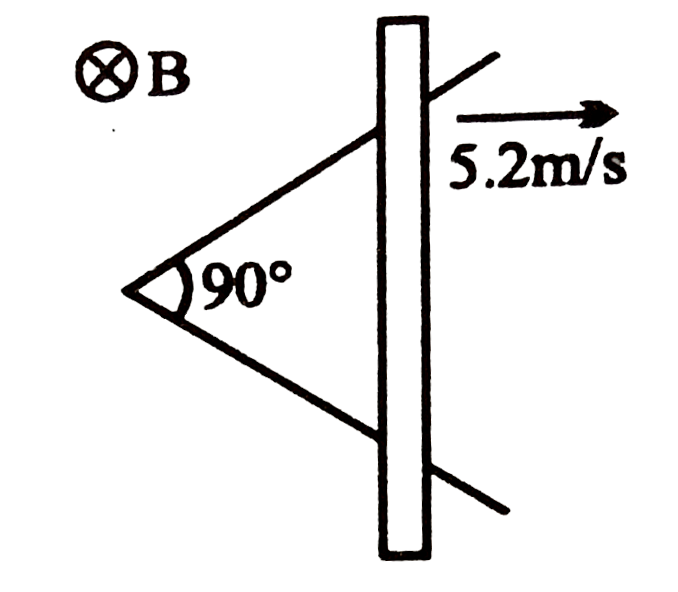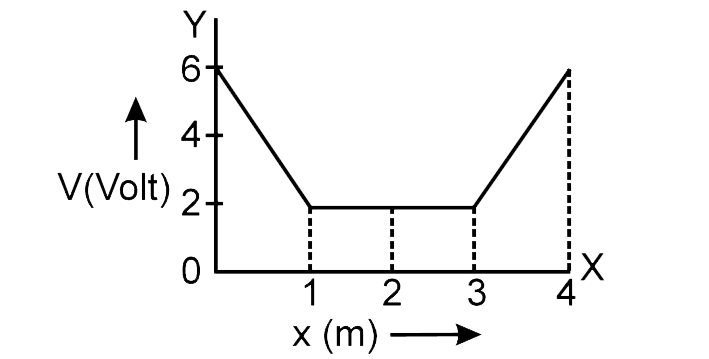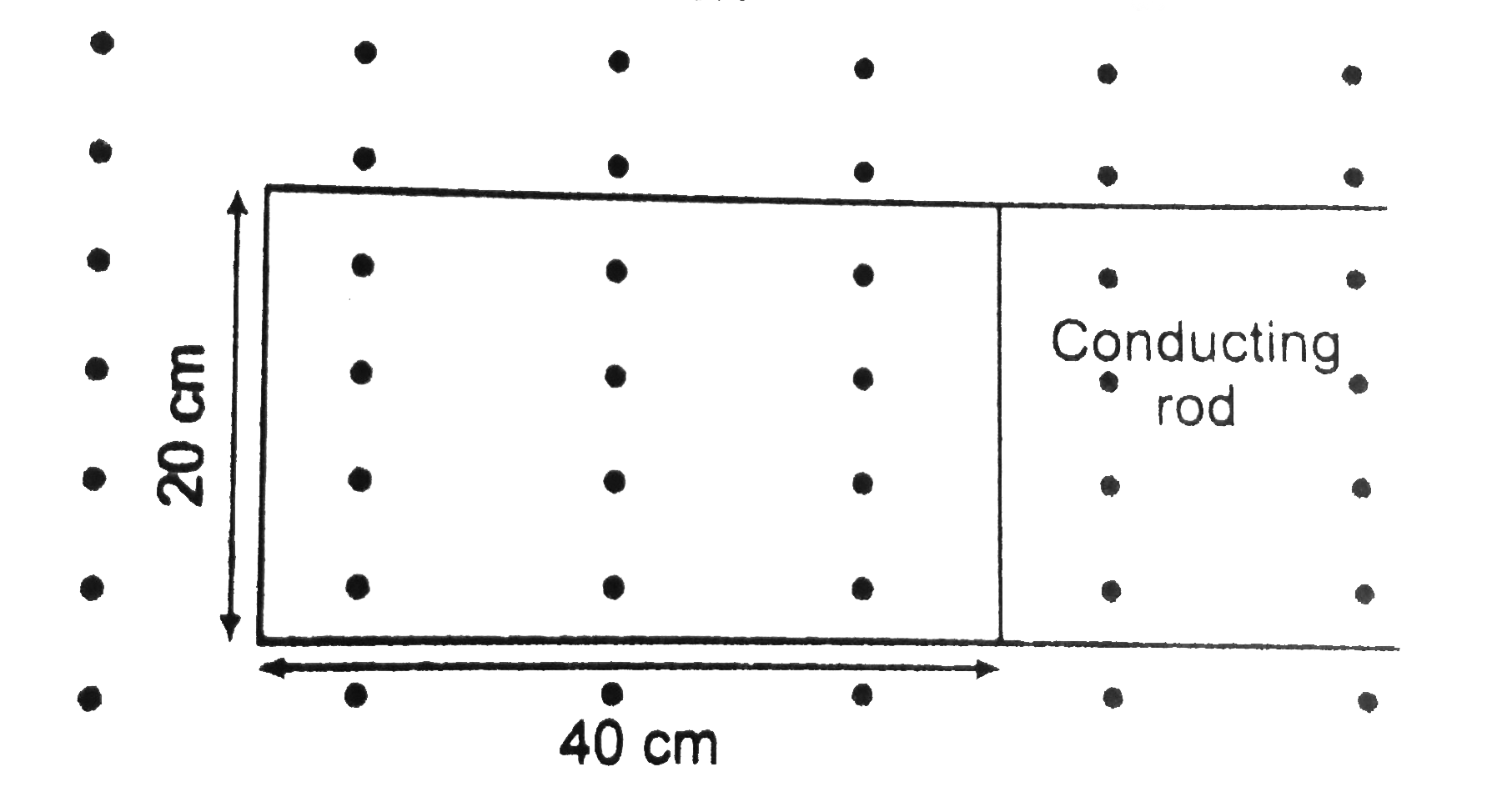Two straight conducting rails form a right angle where their ands are joined. A conducting bar contanct with the rails starts at vertex at the time t=0 & moves symmetrically with a constant velocity of 5.2m/s to the right as shown in figure. A 0.35T magnetic field point out of the page. Calculate:
(i) The flux through the tringle by the rails & ber at t=3.0s.
(ii) The emf around the tringle at that time.

In what manner does the emf around the tringle vary with time.
The correct Answer is:56.8V;
Step by step video, text & image solution for Two straight conducting rails form a right angle where their ands are joined. A conducting bar contanct with the rails starts at vertex at the time t=0 & moves symmetrically with a constant velocity of 5.2 m//s to the right as shown in figure. A 0.35 T magnetic field point out of the page. Calculate: (i) The flux through the tringle by the rails & ber at t=3.0 s. (ii) The emf around the tringle at that time. In what manner does the emf around the tringle vary with time. by Physics experts to help you in doubts & scoring excellent marks in Class 12 exams.
Topper's Solved these Questions
- BOOK - MOTIONCHAPTER - ELECTROMAGNETIC INDUCTIONEXERCISE - EXERCISE-4 (LEVEL-I)11videos
ELECTROMAGNETIC INDUCTION
- BOOK - MOTIONCHAPTER - ELECTROMAGNETIC INDUCTIONEXERCISE - EXERCISE-4 (LEVEL-II)13videos
ELECTROMAGNETIC INDUCTION
- BOOK - MOTIONCHAPTER - ELECTROMAGNETIC INDUCTIONEXERCISE - EXERCISE-3 (LEVEL-I)13videos
ELECTROMAGNETIC INDUCTION
- BOOK - MOTIONCHAPTER - ELECTRO MAGNETIC WAVES EXERCISE - EXERCISE - 3 (SECTION - B)8videos
ELECTRO MAGNETIC WAVES
- BOOK - MOTIONCHAPTER - ELECTROMAGNETISMEXERCISE - Exercise136videos
ELECTROMAGNETISM
Similar Questions
A long solenoid has 20 turns per cm and carries a current i. the magnetic field at its centre is 6.28×10−2Wb/m2. Another long solenoid has 100 turns per cm and it carries a current i/3 . The value of the magnetic field at its centre is
07:22View SolutionAn infinitely long cylinder is kept parallel to an uniform magnetic field B directed along positive z-axis. The direction of induced current as seen from the z-axis will be
07:22View SolutionA charged ring of mass m = 50 gm, charge 2 coulomb and radius R = 2m is placed on a smooth horizontal surface. A magnetic field varying with time at a rate of (0.2 t) Tesla/sec is applied on to the ring in a direction normal to the surface of ring. Find the angular speed attained in a time t1=10sec.
04:21View SolutionWhich of the following is not an electromagnetic wave?
04:35View SolutionThe variation of electric potential with distance from a fixed point is shown in figure. What is the value of electric field at x=2m -
 04:50View Solution
04:50View SolutionFigure shows a conducting rod of negligible resistance that can slide on smooth U-shaped rail made of wire of resistance 1Omega//m . Position of the conducting rod at t=0 is shown. A time dependent magnetic field B=2t tesla is switched on at t=0 The current in the loop at t=0 due to induced emf is
04:40View SolutionFigure shows a conducting rod of negligible resistance that can slide on smooth U-shaped rail made of wire of resistance 1Ω/m. Position of the conducting rod at t=0 is shown. A time dependent magnetic field B=2t tesla is switched on at t=0

At t=0, when the magnetic field is switched on, the conducting rod is moved to the left at constant speed 5cm/s by some external means. At t=2s, net induced emf has magnitudeView SolutionA conducting rod of length is moved at constant velocity v0 on two parallel, conducting, smooth, fixed rails, that are placed in a uniform constant magnetic field B perpendicular to the plane for the rails as shown in Fig. A resistance R is connected between the two ends of the rails.
Then which of the following is/are correct:
 06:52View Solution
06:52View SolutionTwo straight conducting rails form a right angle where their ends are joined. A conducting bar in contact with the rails starts at the vertex at time t = 0 and moves with constant velocity v along them as shown in Fig. A magnetic field vec(B) is directed into the page. the induced emf in the circuit at any time t is proportional to
05:24View SolutionA pair of parallel conducting rails lie at right angle to a uniform magnetic field of 2.0T as shown in the fig. two resistor 10Omega and 5Omega are to slide without friction along the rail. The distance between the conducting rails is 0.1m . Then
06:44View SolutionTwo straight conducting rails form a right angle where their ands are joined. A conducting bar contanct with the rails starts at vertex at the time t=0 & moves symmetrically with a constant velocity of 5.2m/s to the right as shown in figure. A 0.35T magnetic field point out of the page. Calculate:
(i) The flux through the tringle by the rails & ber at t=3.0s.
(ii) The emf around the tringle at that time.

In what manner does the emf around the tringle vary with time.07:15View SolutionFigure shows a conducting rod of negligible resistance that can slide on smooth U- shaped rail made of wire of resistance 1Omega//m . Position of the conducting rod at t=0 is shown. A time t dependent magnetic filed B=2t Tesla is switeched on t=0 At t=0 , when the magnetic field to switched on, the conducting rod is moved to the left at constant speed 5cm//s by some external means. The rod moves perpendicular to the rails. At t=2s , induced emf has magnitude.
View SolutionA conducting bar mass m and length l moves on two frictionless parallel conducting rails in the presence of a uniform magnetic field B_(0) directed into the paper. The bar is given an initial velocity v_(0) to the right and is released at t = 0 . The velocity of the bar as a function of time is given by
02:44View SolutionTwo straight conducting rails from a right angle where their end are joined. A conducting bar polaced over the rails starts at vertex at the time t=0 and moves with a constant velocity v to the right as shown in the figure. Calculate (a) the flux through the triangle (isosceles) by the rails and bar at t=t_(0) the emf around the triangle at that time (c) in what manner does the emf around the triangle vary with time
02:45View SolutionA conducting bar of mass m and length l moves on two frictionless parallel rails in the presence of a constant uniform magnetic field of magnitude B directed into the page as shown in the figure . The bar is given an initial velocity v_(0) towards the right at t = 0. Then the
04:23View SolutionThe two conducting rails are placed perpendicular to each other, such that their ends are joined as shown in figure. A conducting bar is now placed over the rails and start moving with constant velocity v starting from the vertex at time t = 0. (i) The flux through the triangle (isosceles) by the rails and bar at t=t_(0) . (ii) The emf around the triangle at that time. (iii) In what manner does the emf around the triangle vary with time.
04:08View Solution

